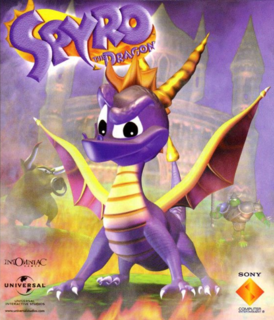Spyro the Dragon is a great little platform game despite it's minor flaws.
The story of Spyro the Dragon follows the adventure of Spyro, a little purple dragon, and his pet dragon fly Sparx. Spyro lives in the Dragon World, a peaceful realm consisting of five different zones. Each individual zone houses its own family of dragons. All the dragons are living normal lives until one day, the day when the vile and evil Gnasty Gnorc attacks. Using his magic he turns all the dragons in to crystal statues, apart from Spyro because he was too small to be effected by the spell. After these events Spyro takes it upon himself to rescue his family from their crystal imprisonments and to put an end to Gnasty Gnorc.
The game play of Spyro the Dragon is certainly very traditional for its genre, but it included some features that make it unique to the likes of Super Mario 64. For starters Spyro can fly for short periods of time. At the top of a jump pressing the jump button a second time will make Spyro glide though the air. The longer he glides for the lower towards the ground he gets though, so timing your glides properly to reach certain platforms is essential to your success.
As well as being able to fly Spyro can also breathe fire and head-charge enemies – and these two attacks will be used a lot. Throughout the course of the game you'll encounter all sorts of different looking enemies, but despite this they'll always come in two categories; un-armoured and armoured. The un-armoured enemies are technically 'weaker' then the armoured ones because you can kill then in more ways. The armoured enemies can only be killed with a head-charge. But you'll also encounter certain enemies that are resistant to both your forms of attacks, and to kill these you'll need to be temporarily powered up by a fairy that you'll encounter in certain levels (there's two types of fairies though, the ones that power you up aren't the ones that let you save your game data).
The only disappointing thing, in my eyes, is that the enemies are generally easy to defeat. It doesn't really subtract anything from the game having easy to kill enemies, but I'd have liked to have seen the difficulty budged up a little bit.
One of the big features of 3D platform games such as Super Mario 64 and Banjo-Kazooie is that you have to collect things to progress through the game (Power Stars in Super Mario 64 and Jiggies in Banjo-Kazooie). Spyro the Dragon also carries this trend along.
The main objective of Spyros' quest is to rescue the dragons from their crystallized states, and rescuing a dragon from their crystallized state is the equivalent to getting a Power Star or a Jiggie. The game has six hub worlds, and each world consists of three main levels, a special flying level and a boss level (except the sixth world which differs slightly). Each of the three main levels and boss levels have Dragon Crystals hidden in them for Spyro to find and so does each of the hub worlds. The flying level simply serves a purpose of means to acquire more gems (Spyros' equivalent of coins or musical notes).
But as well as finding the Crystal Dragon statues you're also required to collect other items to progress. To go from one world to another you have to talk to these balloonists to let them use their balloon for the travel, but they don't let you use them unless you're reached certain requirements. For instance one balloonist only lets you use his balloon once you've rescued ten dragons while another only lets you once you've acquired a collective total of 1200 gems. So collecting is a must in Spyro the Dragon, but it isn't as difficult as in Super Mario 64 or Banjo-Kazooie, so those who didn't like the collective nature of those games will have a better experience with Spyro.
Spyro the Dragon is visually great for a PlayStation title. It doesn't look as good as some of the games available for the Nintendo 64, such as Banjo-Kazooie, but it still looks great despite this. The animations look great too, and this really adds to the experience. Musically the game is good too but, again, it lacks something in the music department compared to the likes of Banjo-Kazooie and Super Mario 64.
The only main criticism I have of Spyro the Dragon is that it is generally very easy. As I've already said a lot of the enemies don't cause any cause for concern, and the same can be said about the bosses too. Every single boss in Spyro the Dragon is easy – including the last boss. You'll probably have a harder time against King Bob Omb in Super Mario 64 then you will against any of the bosses in this game.
Spyro the Dragon is a great little platform game. It has a few problems that stop it quite reaching the level of quality that others in its genre have reached, but despite this it is still a game that any platform fan should definitely play.
Review by: James Widdowson
Score: 8.6/10

